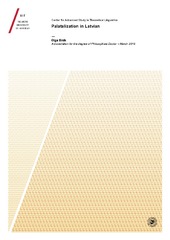| dc.contributor.advisor | Kramer, Martin | |
| dc.contributor.author | Urek, Olga | |
| dc.date.accessioned | 2016-07-28T12:40:36Z | |
| dc.date.available | 2016-07-28T12:40:36Z | |
| dc.date.issued | 2016-05-23 | |
| dc.description.abstract | Palatalization is very commonly attested across languages and has sparked considerable interest in fields like linguistic typology, phonetics, and phonology. However, palatalization notoriously exhibits a large degree of diversity, both cross-linguistically and within individual languages, which, on the one hand, precludes a straightforward phonetic explanation, and, on the other hand, poses considerable challenges for formal phonological accounts striving to provide a unified analysis of all processes subsumed under this cover term.
In this dissertation, I undertake a systematic investigation of a group of palatalization processes in Modern Standard Latvian, namely assimilatory palatalization, diminutive palatalization, and palatal assimilation in consonant clusters. The intricate Latvian patterns have hitherto received very little attention in the generative phonological literature.
The relatively narrow empirical focus of this work made it possible to examine the phenomena in considerable depth and to uncover some regularities and dependencies that have been previously overlooked. I develop a representational and constraint-based analysis of Latvian palatalization. The substance-free approach to a process that has traditionally been regarded as a classic example of a phonetically motivated rule developed in this thesis provides a descriptively adequate, explanatory and formally simple analysis of assimilation patterns that posed considerable challenges for traditional phonetically-driven approaches, while at the same time revealing a complex inter-relation of different phonological and morphological phenomena within a given grammar. | en_US |
| dc.description.doctoraltype | ph.d. | en_US |
| dc.description.popularabstract | Palatalization – a phenomenon characterized by a consonant acquiring a secondary palatal articulation or shifting its primary place of articulation to or closer to the palatal region - is commonly attested across languages. However, palatalization notoriously exhibits a large degree of diversity, both cross-linguistically and within individual languages, which poses considerable challenges for formal phonological accounts. In this dissertation, I undertake a systematic investigation of a group of palatalization processes in Modern Standard Latvian, which have hitherto received very little attention in the literature. The relatively narrow empirical focus of this work made it possible to examine the phenomena in considerable depth and to uncover some regularities and dependencies that have been previously overlooked. I also develop a formal analysis of Latvian palatalization, and show how the phenomenon interacts with other aspects of Latvian phonology and morphology. | en_US |
| dc.identifier.uri | https://hdl.handle.net/10037/9501 | |
| dc.identifier.urn | URN:NBN:no-uit_munin_9059 | |
| dc.language.iso | eng | en_US |
| dc.publisher | UiT Norges arktiske universitet | en_US |
| dc.publisher | UiT The Arctic University of Norway | en_US |
| dc.rights.accessRights | openAccess | |
| dc.rights.holder | Copyright 2016 The Author(s) | |
| dc.rights.uri | https://creativecommons.org/licenses/by-nc-sa/3.0 | en_US |
| dc.rights | Attribution-NonCommercial-ShareAlike 3.0 Unported (CC BY-NC-SA 3.0) | en_US |
| dc.subject | VDP::Humanities: 000::Linguistics: 010::General linguistics and phonetics: 011 | en_US |
| dc.subject | VDP::Humaniora: 000::Språkvitenskapelige fag: 010::Allmenn språkvitenskap og fonetikk: 011 | en_US |
| dc.title | Palatalization in Latvian | en_US |
| dc.type | Doctoral thesis | en_US |
| dc.type | Doktorgradsavhandling | en_US |


 English
English norsk
norsk
